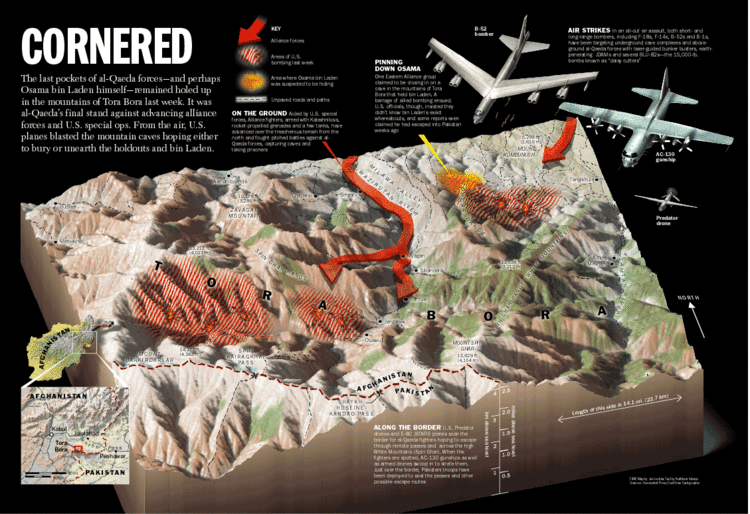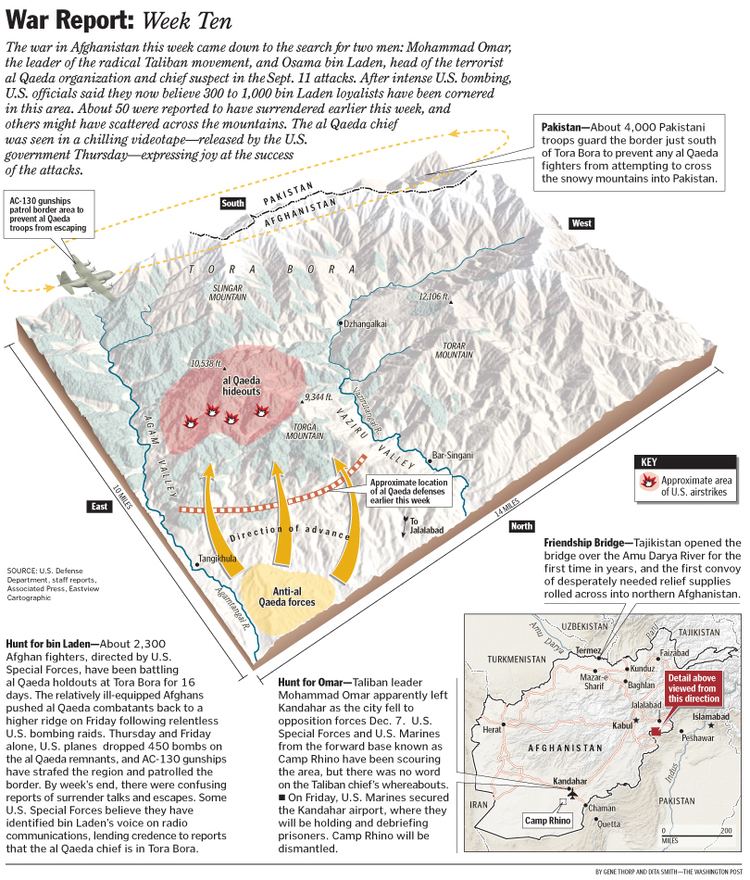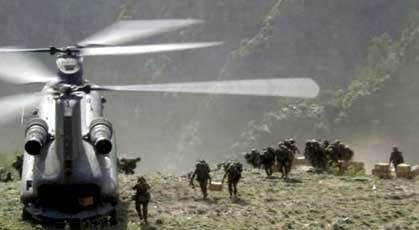Coalition NoneNorthern Alliance Unknown 200 killed | Date December 2001 | |
 | ||
Similar War in Afghanistan, death of Osama bin Laden, Battle of Qala‑i‑Jangi, Operation Anaconda, Fall of Kandahar | ||
The Battle of Tora Bora was a military engagement that took place in Afghanistan from December 6, 2001 to December 17, 2001, during the opening stages of the War in Afghanistan launched by the United States following the September 11 attacks. The U.S. and its allies believed that Osama bin Laden, the founder of al-Qaeda, was hiding in the mountains at Tora Bora.
Contents
- The hunt for bin laden
- Battle
- Furys account
- Guantanamo captives accounts of the battle
- Aftermath
- Tora Bora fortress
- References

The allied forces overran Taliban and al-Qaeda positions and heard bin Laden's voice in intercepted radio transmissions several times, but they failed to kill or capture him. Bin Laden escaped to the Federated Tribal Areas of Pakistan, where he stayed for nearly a decade before being located and killed by Navy SEALs of the United States Navy Special Warfare Development Group in May 2011.

Tora Bora (Pashto: تورا بورا, black cave) is a cave complex situated in the White Mountains of eastern Afghanistan, near the Khyber Pass.

In 2001, the United States and its allies suspected the complex was being used by al-Qaeda and was the location of the commander Osama bin Laden's headquarters. It was variously described as a multi-storied cave complex harnessing hydroelectric power from mountain streams, or a lower-rise dwelling with hotel-like corridors capable of sheltering more than 1,000 people. It was said to contain a large cache of ammunition, such as Stinger missiles left over from the 1980s. Based on a description leaked from government source, national U.S. newspapers carried a cartoon drawn of the complex. Donald Rumsfeld, Secretary of Defense, displayed the cartoon in a discussion of Tora Bora on Meet the Press in October 2001.

In the early 1980s, the United States CIA officers had assisted the mujahideen in extending and shoring up the caves in Operation Cyclone to use for resistance during the Soviet invasion of Afghanistan. The US then supported their effort, and it was not until several years later that the Taliban formed and took control of the country, enforcing fundamentalist rule. Several cave areas were used in much earlier periods, as the difficult terrain formed a natural defensive position and had been used by tribal warriors fighting foreign invaders since ancestral times.
The British journalist Abdel Bari Atwan, author of The Secret History of Al Qaeda (2006), had visited Bin Laden at Tora Bora in 1996. He wrote that at the time, bin Laden lived in a "humble cave" with basic heating equipment.
The hunt for bin laden
Battle
At the end of 2001, al-Qaeda fighters were still holding out in the mountains of the Tora Bora region. Aerial bombardment ensued, including the use of large bombs known as daisy cutters.
On December 3, 2001, a group of 20 U.S. CIA National Clandestine Service (NCS) and 5th Special Forces Group (Airborne) (SFG[A]) ODA572 team members, code-named Jawbreaker, were inserted by helicopter in Jalalabad, Afghanistan to begin an operation against them. On December 5, 2001, Afghan Northern Alliance fighters wrested control of the low ground below the mountain caves from al-Qaeda fighters. The Jawbreaker team and SF teams equipped with laser markers (known as laser designators in the U.S. military) called in Air Force bombers to take out targets; non-stop heavy air strikes including laser-guided bombs and missiles lasted for 72 hours. The al-Qaeda fighters withdrew to higher fortified positions and dug in for the battle. Approximately a week later, 70 special forces operators from the Army Delta Force's A Squadron, Navy DEVGRU, and Air Force STS arrived overland by vehicle to support the bombing campaign with ground forces. Two British SBS Commandos were embedded with A Sqn Delta, and have described the battle as fierce but one sided. During the hours of darkness, the al-Qaeda fighters would light fires, which would reveal their specific location and aid laser-designated targeting for air-launched weapons.
The Northern Alliance fighters continued a steady advance through the difficult terrain, backed by air strikes and U.S. and British Special Forces. Facing defeat, al-Qaeda forces negotiated a truce with a local Afghan militia commander to give them time to surrender their weapons. In retrospect, however, some critics believe that the truce was a device to allow important al-Qaeda figures, including Osama bin Laden, to escape.
On December 12, 2001, the fighting flared again, possibly initiated by a rear guard buying time for the main force's escape through the White Mountains into the tribal areas of Pakistan. Tribal forces backed by U.S. special operations troops and air support pressed ahead against fortified al-Qaeda positions in caves and bunkers scattered throughout the mountainous region. Twelve British SBS commandos, and one British Royal Signals Specialist from 63 Signals squadron (now known as 18SFUK), accompanied the U.S. special operations forces in attacking the cave complex at Tora Bora. Special Forces Operators of the German KSK took part in the battle as well. They were reportedly responsible for protecting the flanks in the mountains and conducted reconnaissance missions.
The U.S. focus increased on the Tora Bora. Local tribal militias, paid and organized by Special Forces and CIA SAD paramilitary, numbering over 2,000 strong, continued to mass for an attack as heavy bombing continued of suspected al-Qaeda positions.
Matthew Forney of Time Magazine reported on December 11, 2001 that the allied forces did not find massive bunkers but small outposts and a few minor training camps. He said reporters were allowed to see the "rough bunkers" deep in the mountains, which were still "remarkable."
By December 17, 2001, the last cave complex had been taken and their defenders overrun. US forces continued searching the area into January, but did not find any signs of bin Laden or the al-Qaeda leadership. According to his book published in 2005, the former CIA officer, Gary Berntsen, led the CIA team (consisting primarily of CIA Paramilitary Officers from Special Activities Division) in Afghanistan tasked with locating bin Laden during the armed conflict.
In his book Jawbreaker (2005), Berntsen said that his team had pinpointed bin Laden's location. He wrote that a number of al-Qaeda detainees later confirmed that bin Laden had escaped into Pakistan via an easterly route through snow-covered mountains to the area of Parachinar, Pakistan. He believed that bin Laden could have been captured at the time if the United States Central Command had committed the troops which Berntsen had requested. In a 2005 interview, the former CIA officer Gary Schroen concurred with Berntsen's opinion. Pentagon documents suggest bin Laden escaped at Tora Bora.
In an October 2004 opinion article in The New York Times, General Tommy Franks wrote,
"We don't know to this day whether Mr. bin Laden was at Tora Bora in December 2001. Some intelligence sources said he was; others indicated he was in Pakistan at the time...Tora Bora was teeming with Taliban and Qaeda operatives ... but Mr. bin Laden was never within our grasp."
Franks retired in 2003, but had commanded U.S. forces in Afghanistan at the time.
Many enemy fighters made their escape in the rough terrain and slipped away into the tribal areas of Pakistan to the south and east. Allied forces estimated that around 200 of the al-Qaeda fighters were killed during the battle, along with an unknown number of anti-Taliban tribal fighters. No coalition deaths were reported.
In 2009, the United States Senate Committee on Foreign Relations under John Kerry's chairmanship reviewed the failed attempt to capture or kill Osama bin Laden in the mountains of Tora Bora and placed the blame with Secretary of Defense Donald Rumsfeld and General Tommy Franks for not assembling enough U.S. troops to seal the mountainous area during the operation. After studying the matter, the Committee came to a conclusion that Osama bin Laden most likely was present at Tora Bora and his subsequent escape prolonged the war in Afghanistan.
The Uyghur Turkistan Islamic Party's "Islamic Turkistan" magazine in its 9th edition released an obituary of TIP fighters killed in Pakistan and Afghanistan. Yusuf (Idris al-Turkistani) was killed in Waziristan, while Toxti Haji (Abdul Muhsin al Turkistani) died on October 7, 2001 on Tora Bora mountain after the training camp he was in was bombed by American planes. The Tora Bora battle saw Abu Omar al-Turkistani's participation. The Islamic Jihad Union enlisted Turkistani as a member. An exodus of Uighurs followed after the airstrikes by the Americans in 2001 on their camp at Tora Bora.
Fury's account
A former Delta Force commander, using the pen name "Dalton Fury", who fought at Tora Bora, wrote that bin Laden escaped into Pakistan on or around December 16, 2001. Fury gives three reasons for why he believes bin Laden was able to escape: (1) the US mistakenly thought that Pakistan was effectively guarding the border area, (2) NATO allies refused to allow the use of air-dropped GATOR mines, which would have helped seal bin Laden and his forces inside the Tora Bora area, and (3) over-reliance on native Afghan military forces as the main force deployed against bin Laden and his fighters. Fury states that, as it was Ramadan, the Afghan forces would usually leave the battlefield in the evenings to break their day-long fasts. He suggested this allowed the al-Qaeda forces a chance to regroup, reposition, or escape.
In an October 2008 interview on 60 Minutes, Fury said that his Delta Force team and CIA Paramilitary Officers traveled to Tora Bora after the CIA had identified bin Laden's location. Fury's team proposed an operation to attack bin Laden's suspected position from the rear, over the 14,000 foot-high mountain separating Tora Bora from Pakistan. He said unidentified officials at higher headquarters rejected his proposal. Fury suggested dropping GATOR mines in the passes leading away from Tora Bora, but this was also denied. Fury and his team approached the suspected position from the front and were within 2,000 meters, but withdrew because of uncertainty over the number of al-Qaeda fighters and a lack of support from allied Afghan troops.
A short time later, the Afghan military forces declared a cease fire with al-Qaeda. In his 2008 book, Kill bin Laden, Fury described the following. His team planned to advance again on the al-Qaeda forces, but after the cease-fire, Afghan soldiers drew their weapons on the US soldiers. After 12 hours of negotiations, the Afghans stood down, but bin Laden and his bodyguards had left. Fury reports that his team intercepted and interpreted radio calls by bin Laden in the afternoon of December 13, 2001. He said to his fighters, "the time is now, arm your women and children against the infidel." Then, after a few hours of bombing, bin Laden broke radio silence again, saying: "Our prayers were not answered. Times are dire and bad. We did not get support from the apostate nations who call themselves our Muslim brothers. Things might have been different." Fury said that Bin Laden's final words to his fighters that night were "I'm sorry for getting you involved in this battle, if you can no longer resist, you may surrender with my blessing."
During his interview on 60 Minutes to discuss his book, Fury said that his team saw a group whom they believed to be bin Laden and his bodyguards entering a cave. The team called down several bombing attacks on the site, and believed that they had killed bin Laden. Six months later, US and Canadian forces returned and checked several caves in the area, finding remains of al-Qaeda fighters, but not of bin Laden. Fury thought that bin Laden was injured during the bombing of the cave, but was hidden, given medical care, and assisted out of the area into Pakistan by allied local Afghans.
Guantanamo captives' accounts of the battle
U.S. authorities have justified the continued detention of several dozen Afghan Guantanamo captives by the suspicion they had participated in the battle of Tora Bora, had been present during the battle, or had passed through the area of the battle before or after it concluded, or helped Osama bin Laden to escape.
In September 2007, Ayman Saeed Abdullah Batarfi, a Yemeni medical doctor held as an enemy combatant by the United States, was reported to have described the conditions during the battle:
"Most of all the total guns in the Tora Bora area was 16 Kalashnikovs and there are 200 people." He also said, "He [Osama bin Laden] came for a day to visit the area and we talked to him and we wanted to leave this area. He said he didn't know where to go himself and the second day he escaped and was gone."
Aftermath
Following Tora Bora, U.S. and U.K. forces and their Afghan allies consolidated their position in the country. The Taliban and al-Qaeda forces did not give up and went into hiding. A Loya jirga or grand council of major Afghan factions, tribal leaders, and former exiles, an interim Afghan government, was established in Kabul under Hamid Karzai. Mullah Saifur Rehman, a Taliban fugitive in Paktia Province, began rebuilding some of his militia forces in support of the anti-US fighters. They totaled over 1,000 by the beginning of Operation Anaconda in March 2002. The insurgents planned to use the region as a base for launching guerrilla attacks and possibly a major offensive in the style of the mujahedin during the 1980s.
U.S. forces established their main base at Bagram Air Base just north of Kabul. They used Kandahar International Airport as an important base for accepting and distributing supplies and personnel. Several outposts were established in eastern provinces to hunt for Taliban and Al-Qaeda fugitives. The number of U.S. troops operating in the country would eventually grow to more than 10,000 as efforts against the Taliban and al-Qaeda were increased.
In 2009, a U.S. Senate report concluded that the failure to capture bin Laden "[laid] the foundation for today’s protracted Afghan insurgency and inflaming the internal strife now endangering Pakistan." Al-Qaeda forces began regrouping in the Shahi-Kot mountains of Paktia Province throughout January and February 2002.
In December 2009, New Republic published Peter Bergen's "The Battle for Tora Bora" In his critique of the battle, Bergen reconstructed the U.S. allies engagement at Tora Bora. He said that General Tommy Franks, then U.S. Army chief, refused to deploy 800 Army Rangers from nearby bases to assault the complex of caves where bin Laden was supposedly hiding. Bergen characterized this as "one of the greatest military blunders in recent US history". Bergen says that the US failure to capture bin Laden at the time provided energy to the Taliban. It regrouped and became stronger after U.S. officials diverted forces for the invasion of Iraq in March 2003 and war there.
U.S. intelligence agencies continued to track bin Laden. On May 2, 2011, President Barack Obama confirmed the death of Osama bin Laden, who was living in a compound in the city of Abbottabad, Khyber Pakhtunkhwa province, Pakistan. He was killed by a US Navy SEAL raid on the urban compound.
Tora Bora "fortress"
Tora Bora was variously described by the western media to be an impregnable cave fortress housing 2000 men complete with a hospital, a hydroelectric power plant, offices, a hotel, arms and ammunition stores, roads large enough to drive a tank into, and elaborate tunnel and ventilation systems. Both the British and American press published elaborate plans of the base. When presented with such plans in an NBC interview on Meet the Press, Donald Rumsfeld, the US Secretary of Defense, said, "This is serious business, there's not one of those, there are many of those".
When Tora Bora was eventually captured by the U.S., British and Afghan troops, no traces of the supposed 'fortress' were found despite painstaking searches in the surrounding areas. Tora Bora turned out to be a system of small natural caves housing at most, 200 fighters. While arms and ammunition stores were found, there were no traces of the advanced facilities claimed to exist.
In an interview published by the Public Broadcasting Service, a Staff Sergeant from the U.S. Special Forces Operational Detachment Alpha (ODA) 572, who had been in the Battle of Tora Bora described the caves:
"Again, with the caves, they weren't these crazy mazes or labyrinths of caves that they described. Most of them were natural caves. Some were supported with some pieces of wood maybe about the size of a 10-foot by 24-foot room, at the largest. They weren't real big. I know they made a spectacle out of that, and how are we going to be able to get into them? We worried about that too, because we see all these reports. Then it turns out, when you actually go up there, there's really just small bunkers, and a lot of different ammo storage is up there. – Jeff, Staff Sgt. ODA 572
